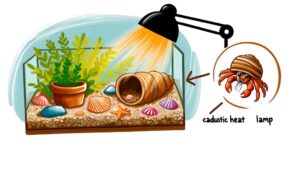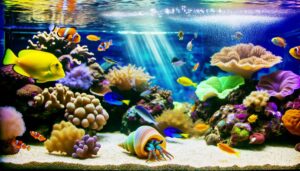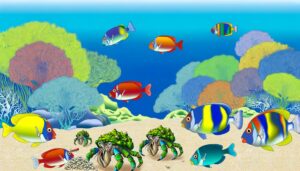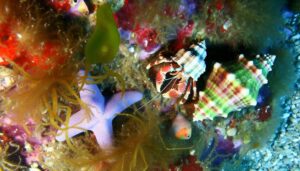Do Hermit Crabs Lose Their Claws?
Yes, hermit crabs can live in water, but it depends on the species. Marine hermit crabs, like Clibanarius tricolor and Pagurus bernhardus, inhabit coral reefs and rocky substrates, playing pivotal roles in nutrient cycling and substrate aeration.
These species are specially adapted to aquatic life, with gills efficient at oxygen extraction from water. In contrast, terrestrial hermit crabs live on land, requiring humid environments to prevent desiccation and using modified gills for respiration.
Both types exhibit fascinating adaptations for their respective habitats. Explore the specific adaptations and behaviors of these intriguing crustaceans to understand their survival strategies further.
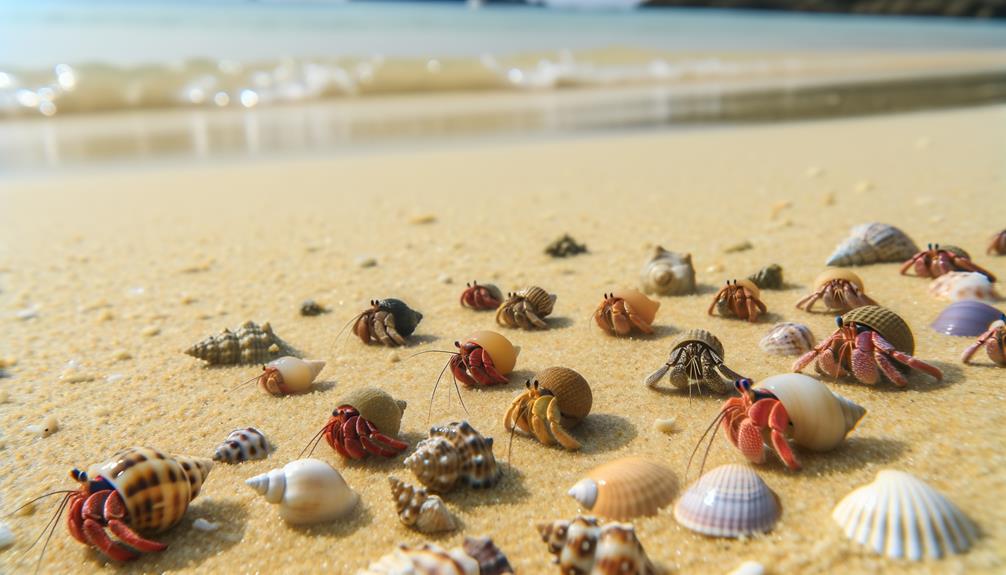
Key Takeaways
- Marine hermit crabs like Clibanarius tricolor and Pagurus bernhardus primarily live in aquatic environments, including coral reefs and rocky shores.
- These crabs rely on specialized gills for respiration, making water habitats essential for their survival.
- Marine hermit crabs contribute to ecosystem health by controlling algae and recycling detritus.
- Their habitat preferences include stable salinity levels, abundant shelter, and food sources found in marine environments.
- While marine species thrive in water, terrestrial hermit crabs adapt to land but still require humid conditions.
Types of Hermit Crabs
Hermit crabs, specifically marine varieties like Clibanarius tricolor and Pagurus bernhardus, exhibit distinct behaviors and habitat preferences that are crucial for their survival.
You'll find Clibanarius tricolor, known as the blue-legged hermit crab, thriving in shallow coral reefs, utilizing abandoned snail shells for protection.
Pagurus bernhardus, the common hermit crab, prefers colder waters and rocky substrates, often found in the Atlantic Ocean.
Both species exhibit resourceful behavior by selecting best-fitting shells for growth and protection against predators.
Marine hermit crabs are essential to their ecosystems, contributing to nutrient cycling and substrate aeration.
Aquatic Hermit Crab Species
While exploring the fascinating world of aquatic hermit crab species, you'll encounter a diverse array of organisms adapted to various marine environments. These species exhibit unique physiological and behavioral traits optimized for underwater living.
To serve your curiosity, consider these four notable hermit crab species:
- Clibanarius tricolor: Known as the Blue-legged Hermit Crab, they thrive in coral reefs and contribute to algae control.
- Pagurus bernhardus: Common in the North Atlantic, they play a vital role in detritus recycling.
- Dardanus megistos: The Red Hermit Crab, found in the Indo-Pacific, is notable for its vibrant coloration.
- Calcinus elegans: The Electric Blue Hermit Crab, inhabiting shallow tropical waters, assists in maintaining coral health.
Understanding these species enhances your ability to support marine biodiversity.
Terrestrial Hermit Crab Species
You'll find that terrestrial hermit crabs exhibit unique adaptations for a land-based habitat. They require humid environments to prevent desiccation and use modified gills for respiration.
Their shell selection process is critical, as they rely on appropriately-sized shells for protection and moisture retention.
Habitat and Adaptations
Terrestrial hermit crab species exhibit remarkable adaptability, thriving in diverse habitats such as coastal forests, sand dunes, and mangroves. To guarantee survival, these crabs have evolved unique adaptations:
- Moisture Retention: They possess modified gills that allow them to extract oxygen from humid air, essential for terrestrial life.
- Dietary Flexibility: They consume a varied diet including detritus, fruits, and even small invertebrates, ensuring nutritional balance.
- Behavioral Adjustments: Nocturnal activity patterns help them avoid predators and minimize water loss.
- Social Structures: Aggregation behavior aids in locating food and mates, and enhances survival rates.
Shell Selection Process
Hermit crabs carefully evaluate potential shells, taking into account factors like size, weight, and opening shape to maximize protection and mobility. You'll notice they perform detailed inspections and often try multiple shells before making a choice. This method guarantees ideal fit, reducing vulnerability to predators and environmental stress. By prioritizing shells with minimal damage and appropriate internal volume, they enhance their chances of survival and reproduction.
Here's a quick comparison of key shell selection factors:
| Factor | Importance |
|---|---|
| Size | Must fit body, allowing growth |
| Weight | Balance between protection and agility |
| Opening Shape | Ensures secure attachment |
| Structural Integrity | Reduces risk of shell breakage |
| Internal Volume | Accommodates body and moisture retention |
Your attention to these factors can greatly improve their well-being.
Habitat Preferences
Marine hermit crabs demonstrate a clear preference for habitats with abundant shelter options and stable salinity levels. You'll find these crustaceans thriving in environments that meet specific criteria to guarantee their survival and well-being.
Key habitat preferences include:
- Rocky Shores: Crabs utilize crevices for protection from predators and harsh environmental conditions.
- Coral Reefs: Offer numerous hiding spots, promoting a complex ecosystem with ample food sources.
- Mangrove Swamps: Provide a mix of saline and freshwater, helping crabs adapt to varying salinity.
- Seagrass Beds: Serve as both a habitat and food source, fostering strong community interactions.
Adaptations to Environments
Crustaceans like hermit crabs have evolved various physiological and behavioral adaptations to thrive in their aquatic environments. You'll find that their gills are specialized for extracting oxygen from water, allowing them to breathe efficiently underwater.
Hermit crabs possess chelipeds (claws) adapted for scavenging food, essential for their survival. Their ability to locate and inhabit discarded shells offers protection against predators. Behavioral adaptations, such as nocturnal activity, reduce predation risk and competition for resources.
Data indicates that hermit crabs can sense chemical cues in the water, aiding in food location and predator avoidance. These adaptations underscore their resilience and highlight how evolution shapes their capacity to flourish in challenging environments, fostering a deeper understanding of marine life's complexity.
Caring for Pet Hermit Crabs
Properly caring for pet hermit crabs requires a thorough understanding of their specific environmental and dietary needs. To ensure the best possible well-being, follow these guidelines:
- Habitat: Maintain a temperature of 75-85°F and humidity levels between 70-80%. Use a hygrometer and thermometer for precision.
- Substrate: Provide a substrate mix of sand and coconut fiber, at least 6 inches deep, to facilitate burrowing.
- Diet: Offer a balanced diet consisting of commercial hermit crab food, fresh fruits, vegetables, and calcium supplements.
- Water: Supply both freshwater and saltwater in shallow dishes, dechlorinated using a suitable water conditioner.
Conclusion
Imagine a hermit crab scuttling across a sandy beach, its shell gleaming in the sun or submerged in a vibrant coral reef. Whether terrestrial or aquatic, hermit crabs have adapted remarkably to their environments.
You'll find terrestrial species in moist, forested areas, while aquatic ones thrive in saltwater ecosystems.
To guarantee your pet hermit crab's health, replicate its natural habitat meticulously, providing appropriate substrates, humidity, and water conditions.
Observing their behaviors offers invaluable insights into these adaptable creatures.

